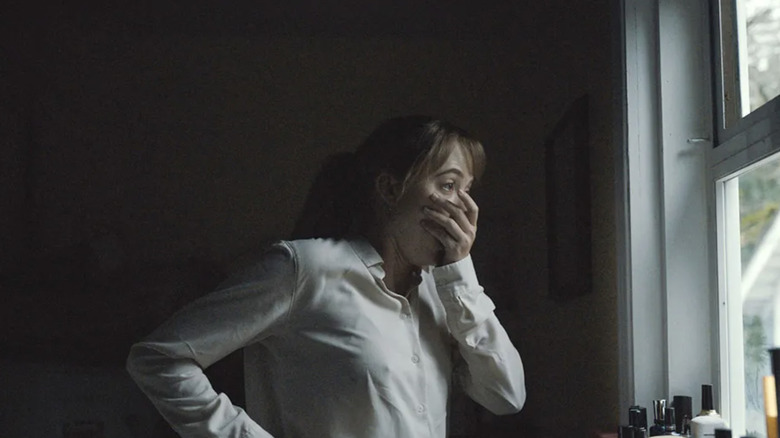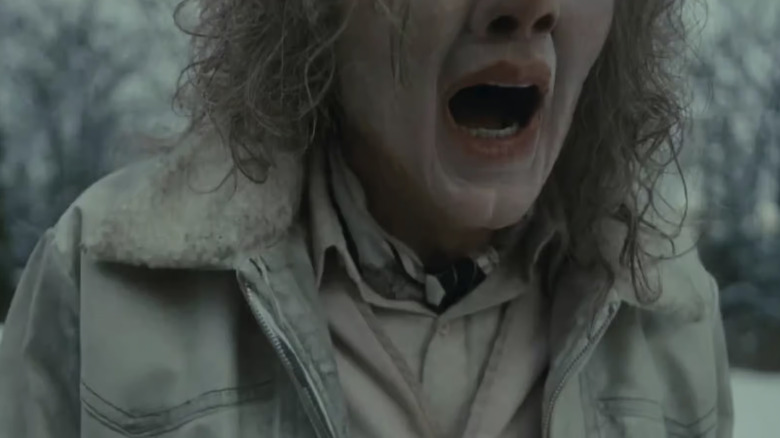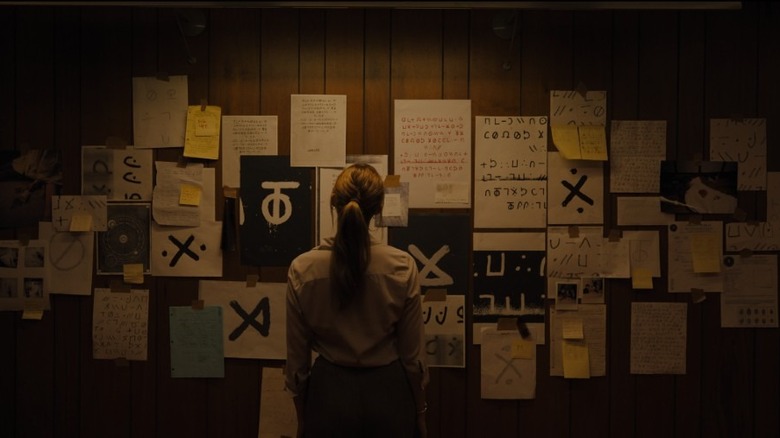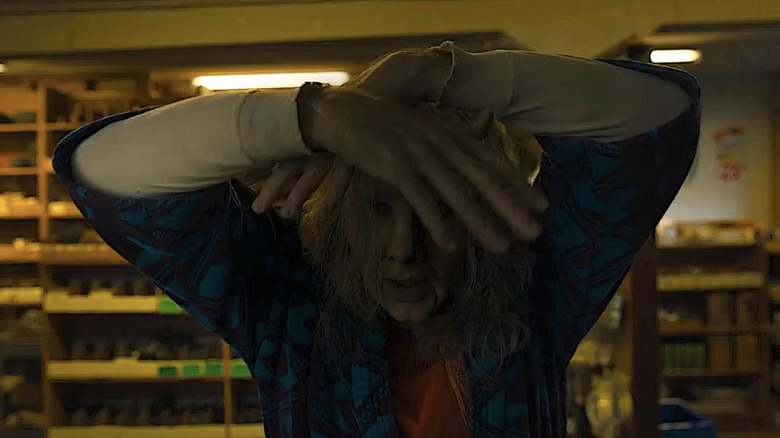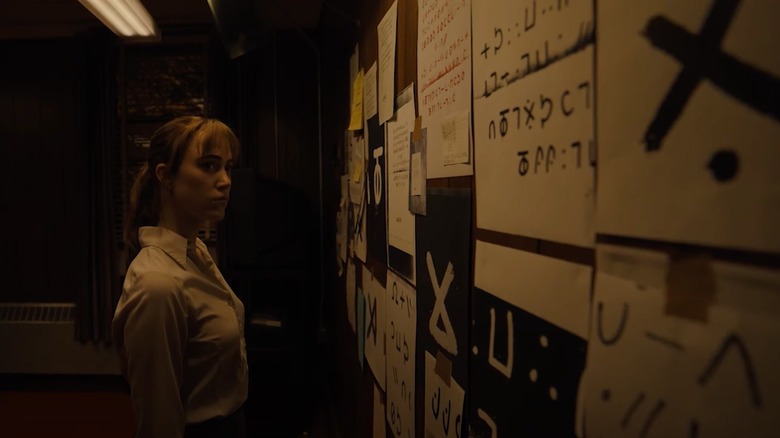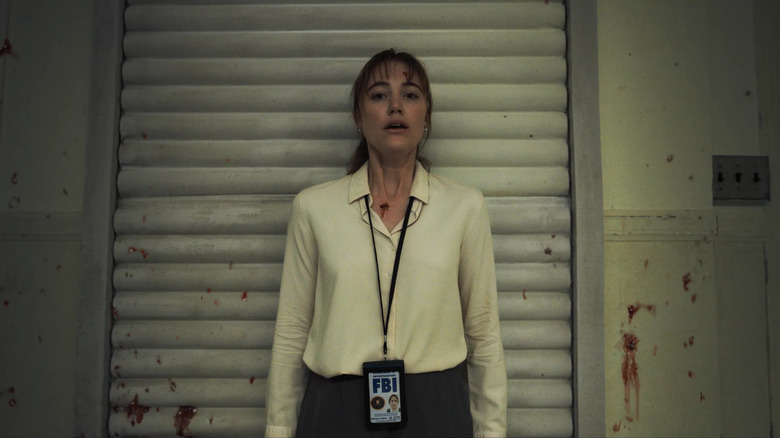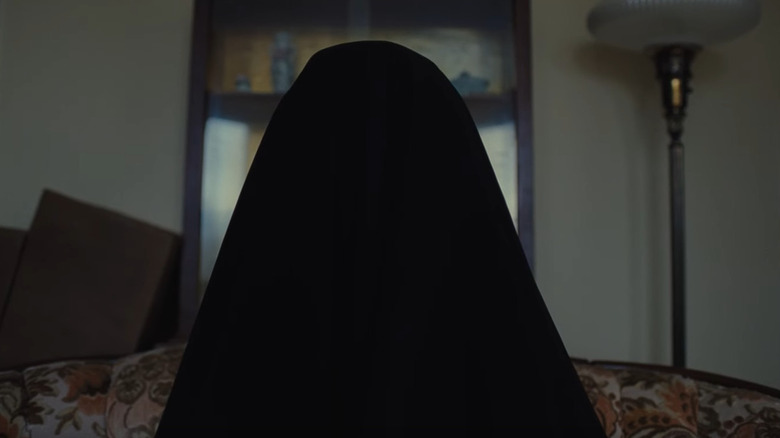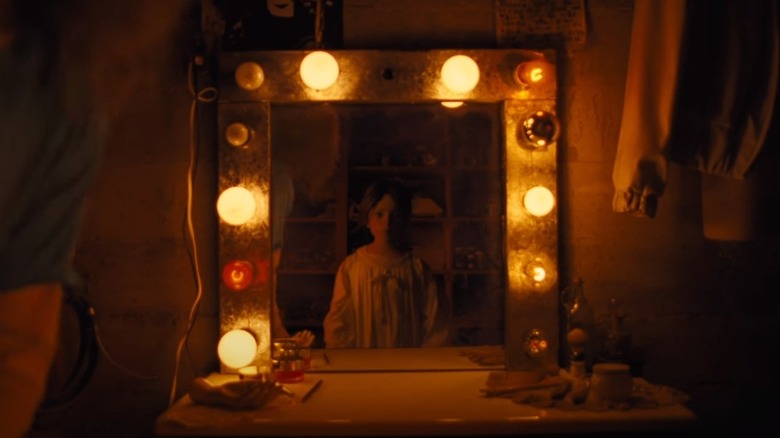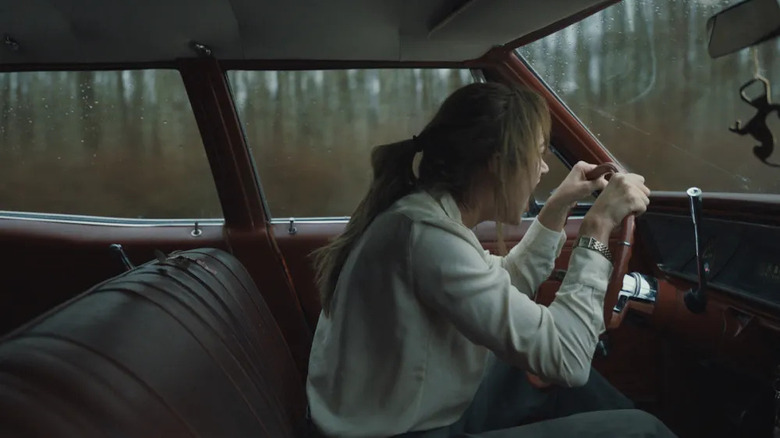Longlegs Ending Explained: Evil With A Capital E
We may receive a commission on purchases made from links.
Spoilers for "Longlegs" follow.
Making a horror film in 2024 about the nature of capital-E Evil is a lofty, impressive endeavor, especially given how many past classics of the genre set the bar so high. Horror movies are never in short supply, and the majority of them are (in one way or another) chasing the same classic high benchmarks, which means that a filmmaker has to find their own unique voice in attempting to play in the same sandbox as, say, "The Exorcist," "The Silence of the Lambs," "Se7en," and others.
Writer/director Osgood Perkins has been steadily developing just the right kind of unique voice within the genre ever since his debut film, "The Blackcoat's Daughter," and now his latest feature, "Longlegs," is his first masterpiece to date, combining a slew of his most effective tropes as an auteur with the perfect choice of material and collaborators. Each of his films has dealt with the occult, and "Longlegs" takes that interest and gives it an analog tangibility that allows the film's supernatural elements to be that much more insidiously believable.
The finale of "Longlegs" is, for all intents and purposes, a depiction of what demonic possession might actually look like, whether the unholy presence manipulating others is genuinely otherworldly or is rather some form of induced mental illness. Ultimately, "Longlegs" argues, the distinction doesn't matter; Evil begets Evil, and it is indestructible. More disturbingly, it may be indistinguishable from Good — there is some Evil lurking within all of us, living with us more closely than any of us would like to admit, waiting for the right moment to make a devious deal with our better natures that traps us forever. To put it another way, the Devil has some long, long legs.
Longlegs meets the birthday girl
"Longlegs" opens with a prologue (or flashback, or memory, or perhaps all three, given the sequence's 4:3 home movie-esque presentation) set in the early 1970s, when glam rock was all the rage (something a quotation from the lyrics of T. Rex's "Get It On" and the sound of guitar feedback indicates right from the jump) and Satanic Chic was still very much in vogue. A young blonde girl (Lauren Acala) runs out into the snow-covered yard of her modest Oregon homestead, intrigued by the arrival of a station wagon down the street.
Looking about but seeing no one around, the girl hears a disembodied voice calling out "cuckoo." Soon enough, the owner of that voice (Nicolas Cage) appears behind her. The man seems to be ecstatic to meet the girl, talking cryptically but excitedly about how she's "the almost birthday girl" and that he's "put on my long legs." During this entire encounter, the man known as Longlegs can only be partially seen, with the majority of his head obscured. As soon as he kneels down into frame, however, the film smash cuts to its opening title sequence, flashes of crime scenes and murder victims periodically appearing while the song "Jewel" by T. Rex plays. Far from just a tonally effective opening, the obscured visage of Longlegs and his connection to some buried past trauma is the film's earliest clue as to what is happening regarding this little girl.
Lee the psychic sidekick
20-odd years later, Lee Harker (Maika Monroe), a junior FBI Agent, is put on assignment to go door-to-door in a suburban neighborhood with a new partner, Agent Fisk (Dakota Daulby) in order to try and get information on an active serial killer in the area. Upon arriving in the neighborhood, Lee identifies a particular house as the killer's based on nothing more than a sixth sense, something Fisk disbelieves to his detriment as his head is blown off the instant the killer (Trey Helten) answers the door. Lee enters the house and captures the killer, who doesn't put up any resistance.
Afterward, Lee is put through a disorienting and confusing barrage of tests by the Bureau, which her superior, Agent Carter (Blair Underwood), explains was actually a test of her potential psychic ability. It turns out Lee scored fairly high, and although she could not be considered a fully fledged psychic, "half-psychic is better than not psychic at all," Carter observes. Thanks to these results, Carter and Agent Browning (Michelle Choi-Lee) decide to hand Harker the case of Longlegs. Although no Agent has ever reported seeing Longlegs nor has any personal information about him, the FBI attribute a series of murders to him based on the letters he leaves for the authorities left at each scene, written in an arcane code.
However, the case has lain dormant for decades based on Longlegs' mysterious M.O.: each murder is of multiple family members who have a 9-ish year old daughter, committed by the parents (usually the father) themselves. Carter believes Longlegs must convince his victims to hurt themselves; after studying the materials, Lee suspects he must be using accomplices. In order to help the serious-minded, work-focused Lee take her mind off the case for a moment, Carter has her drive him home and introduces her to his wife, Anna (Carmel Amit) and young daughter, Ruby (Ava Kelders), who invites Lee to her upcoming birthday party.
Longlegs weaves his web
"Longlegs" is divided into three chapters, the first one entitled "His Letters," a title which refers to Longlegs' mysterious letters, of course, including and especially the one Lee receives in the dead of night, left on her desk by someone breaking into her secluded cabin home. Using the coded letter, written on a birthday card for a 9 year old, Lee cracks the code, discovering that the decoded message refers to a Bible verse, which leads her to more theories and research. While more victims of Longlegs (such as a family whose neighbors believed were vacationing at Disneyland for the past several weeks) are discovered in town, Lee discovers that there is a pattern to Longlegs' killings, especially to when they occur. While each of his victims involve a young girl who was born on the 14th of any given month, the varying dates of when the killings actually occur seem to build a pattern, one which corresponds to a Satanic rune Lee discovers in a book on the occult.
Using the principle of police procedure, Lee and Carter decide to visit the home of the first recorded victims, the Camera family. While investigating the property's old barn, they find in the attic a buried doll of a young girl. When they take the doll to be examined by a coroner (Daniel Bacon), the man is impressed with the doll's craftsmanship and says that it's simply a normal doll; save for the small obsidian ball that once laid in the doll's head, which seems to have some unusual but non-threatening properties.
Meanwhile, somewhere else in Oregon, Longlegs visits his local hardware store to buy more supplies, creeping out the teenage girl (Beatrix Perkins) working the store's counter. Fortunately, she asks her dad for help with the "creepy guy," but Longlegs still leaves with enough material to make some new dolls.
Smile, mom, you're on Carrie Anne Camera
Harker and Carter are shocked to learn that Carrie Anne Camera (Kiernan Shipka), the sole survivor of Longlegs' first murder, has suddenly come out of her decades-long catatonia. As a matter of fact, she began speaking and responding shortly after Harker and Carter found her doll in the barn's attic. After the Agents learn that Longlegs had visited Camera recently (and used Harker's name to sign into the visitor's book with), Harker speaks with Carrie Anne, who tells Lee all about how her family received a gift doll from their local church — supposedly having won some sort of contest — and that shortly thereafter her mother (Lisa Chandler) and father (Jason Day) killed their local priest as well as themselves/each other. It was only because Carrie Anne was at school while it happened that she remained alive, yet she bears no ill will toward Longlegs; quite the opposite, actually, as she claims she'd be willing to do anything the man asked her to do.
Disturbed at how Longlegs could possibly know her name, Carter draws some information out of Lee, who has a faint memory of being visited by a strange man as a child. Carter insists that Lee go speak to her mother, Ruth (Alicia Witt), a highly religious woman who lives alone and often speaks to Lee on the phone, insisting that she say her prayers. At Ruth's house, Lee discovers that Ruth is a hoarder, having never thrown anything away, especially nothing of Lee's (which is why this section of the film is entitled "All of Your Things").
Lee presses her mother for any information about a strange visitor years ago, and Ruth cryptically refuses to discuss the matter. Trying another angle, Lee takes some boxes of her things to her house to parse through them, and makes a horrifying discovery: deep in one of these boxes is a clear picture of Longlegs himself, and the visual sets off yet another alarm bell within Lee's psyche.
The silence of the Longlegs
Using Lee's picture as a guide, the FBI put out a manhunt for Longlegs, who makes himself easy to find as he stands patiently waiting by a bus stop. As Lee, Carter, Browning and other agents have a debriefing session while footage of Longlegs' interrogation plays on a television in the middle of the room, it becomes increasingly (and disturbingly) clear that Longlegs is not reacting to the interviewer off camera, but rather to the people and conversation occurring in the debriefing, which wouldn't happen until after that footage was shot.
Upon being told that Longlegs is being held in a room "right below us," Lee insists on interrogating him herself, even though Carter isn't so sure it's a good idea. When Longlegs sees Lee, he becomes ecstatic, continuing to talk cryptically about birthdays and Lee's desire to join the FBI while eluding Lee's questions about his dolls, how he makes them and what they're for. To some of Lee's questions, Longlegs strongly hints that Ruth has answers. Like so many diabolical, 4D chess playing villains — especially Hannibal Lecter of "The Silence of the Lambs" and John Doe in "Se7en" — Longlegs clearly has the upper hand during this entire interaction. He suddenly enacts the next step of his plan: slamming his face and body against the metal desk in front of him until the bleeding and force of the trauma causes him to die. Lee watches, horrified and helpless.
As the Bureau literally and figuratively clean up the mess, Carter admonishes Lee, furious that they still fail to have any concrete evidence to tie Longlegs to the killings. Lee, meanwhile, is flummoxed, and believes more than ever that Longlegs must have an active accomplice who's still out there.
Mommy and Daddy Longlegs
Despite Carter's insistence that the case is now kaput, Browning tags along with Harker to Ruth's place. While Browning waits in the car, Lee searches her mother's house, discovering a hidden door to a basement area of the house that Lee hadn't noticed previously. The basement turns out to be Longlegs' lair, the place we've seen glimpses of throughout the movie, where Longlegs lived and made his dolls. As Lee rushes back upstairs to tell Browning, she sees her mother, now clad in a nun's habit, blow away the agent with a shotgun, killing her. Lee also finds Longlegs' car, sitting covered in her mother's garage.
Through voiceover and flashback, Ruth tells the story of her history with Longlegs in a fairytale-like manner (this, along with the use of confessional voiceover, is a callback to Perkins' prior features "I Am the Pretty Thing Who Lives in the House" and "Gretel & Hansel"). It seems that on that fateful day when Longlegs visited a young Lee (which we saw in the opening sequence), Ruth confronted the killer, who offered her a deal: work for him and Lee would be spared. Taking the deal, Ruth then became the false front of Longlegs' Satanic machinations, delivering the witchcraft-infused dolls to each family under the guise of them winning a church contest, meaning that each family unwittingly played their part in the occult ritual by willfully inviting the demonic spirit within the doll into their homes.
While Longlegs isn't Lee's biological father, the fact that he'd been living with her mother (and her, until she grew up and moved out) makes him a stepfather of sorts: a Daddy Longlegs, if you will. While wondering how she could've possibly been blind to this all these years, Lee's pursuit of Ruth reveals the answer. Ruth fires her shotgun at a doll of Lee that had been in their yard the whole time, causing the real Lee to briefly lose consciousness as the spell the doll held over her is released.
Happy birthday from Longlegs
The final chapter of "Longlegs" is entitled "Birthday Girls," and as Lee awakens after being released from the doll's control, she realizes that Ruth intends to continue doing Longlegs' work as part of her pact with the Devil to keep Lee safe. Remembering that it is not just her own birthday, but Ruby Carter's as well, Lee jumps in her car and rushes to the Carters', finding Ruth already sitting in the living room, having given Ruby her new doll.
While Carter, Anna, and Ruby all blissfully ignore Lee's warning's that Ruth is the accomplice as well as her pleas to let her take the doll away, Carter insists that Anna go to the kitchen, something Anna winces at before happily agreeing to. While in the kitchen, Carter stabs his wife to death, and Lee then holds her mother at gunpoint, demanding she stop this. Carter emerges from the kitchen, bloodied and brandishing a knife, and is shot by Lee when he refuses to freeze. Lee shoots Ruth, too, her own mother lost to Evil. This final sequence is the film's best demonstration of its unique version of demonic possession; instead of characters speaking in artificially low voices and shouting invectives, they go about their work with a beatific smile.
What we talk about when we talk about Longlegs
The final chapter of the film is also the most powerful demonstration of the story's ambiguity: there's a way of interpreting the events of "Longlegs" in a similar fashion to what Carter and Lee theorize at the beginning, that Longlegs is somehow able to manipulate people's minds like a hypnotist and get them to do what he wants, and that Lee's psychic ability exists and so on. Of course, there's also the view that Longlegs is a literal disciple of Satan, and that the dolls he makes have a magical power over people, including Lee, who has played her part in his occult ritual (a bleak conclusion akin to that of "Rosemary's Baby," "The Wicker Man," "Spellbinder," and others).
As Lee attempts to shoot Ruby's doll and free the girl, her gun clicks empty; a coincidence of bad timing, or the exact outcome the forces of darkness planned for? Is Evil simply a banal force of will perpetuated by disreputable mortals, or is it an eternal, overwhelming entity with its own independent agenda? Is "Longlegs" a film about the horrors of tangible evil, or the unknown terrors of the beyond? We're left to ponder these questions along with Lee, as we're treated to a final view of Daddy Longlegs in his interrogation cell saying "Hail, Satan," before kissing us goodbye and goodnight.
